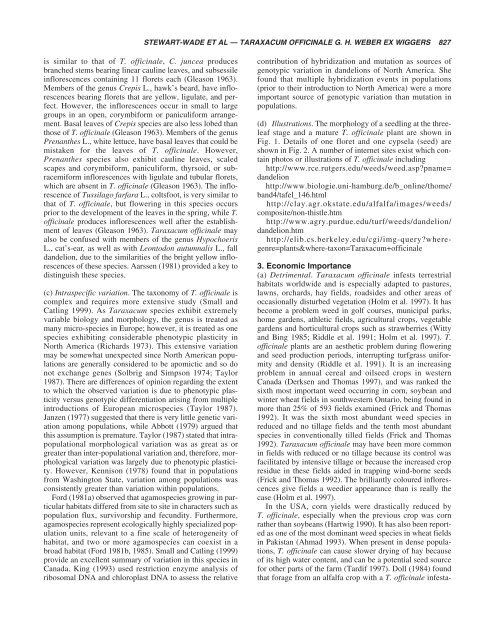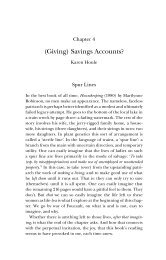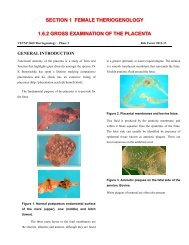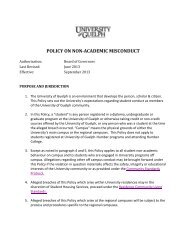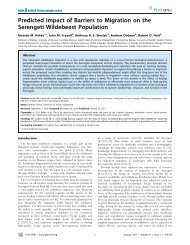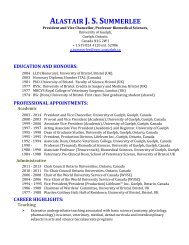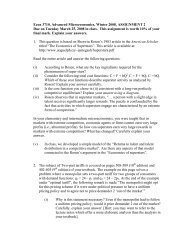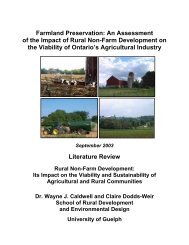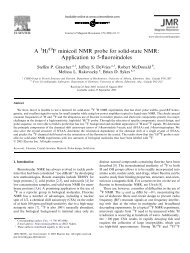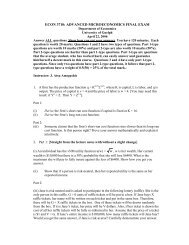The biology of Canadian weeds. 117. Taraxacum officinale G. H. ...
The biology of Canadian weeds. 117. Taraxacum officinale G. H. ...
The biology of Canadian weeds. 117. Taraxacum officinale G. H. ...
Create successful ePaper yourself
Turn your PDF publications into a flip-book with our unique Google optimized e-Paper software.
is similar to that <strong>of</strong> T. <strong>of</strong>ficinale, C. juncea produces<br />
branched stems bearing linear cauline leaves, and subsessile<br />
inflorescences containing 11 florets each (Gleason 1963).<br />
Members <strong>of</strong> the genus Crepis L., hawk’s beard, have inflorescences<br />
bearing florets that are yellow, ligulate, and perfect.<br />
However, the inflorescences occur in small to large<br />
groups in an open, corymbiform or paniculiform arrangement.<br />
Basal leaves <strong>of</strong> Crepis species are also less lobed than<br />
those <strong>of</strong> T. <strong>of</strong>ficinale (Gleason 1963). Members <strong>of</strong> the genus<br />
Prenanthes L., white lettuce, have basal leaves that could be<br />
mistaken for the leaves <strong>of</strong> T. <strong>of</strong>ficinale. However,<br />
Prenanthes species also exhibit cauline leaves, scaled<br />
scapes and corymbiform, paniculiform, thyrsoid, or subracemiform<br />
inflorescences with ligulate and tubular florets,<br />
which are absent in T. <strong>of</strong>ficinale (Gleason 1963). <strong>The</strong> inflorescence<br />
<strong>of</strong> Tussilago farfara L., coltsfoot, is very similar to<br />
that <strong>of</strong> T. <strong>of</strong>ficinale, but flowering in this species occurs<br />
prior to the development <strong>of</strong> the leaves in the spring, while T.<br />
<strong>of</strong>ficinale produces inflorescences well after the establishment<br />
<strong>of</strong> leaves (Gleason 1963). <strong>Taraxacum</strong> <strong>of</strong>ficinale may<br />
also be confused with members <strong>of</strong> the genus Hypochoeris<br />
L., cat’s-ear, as well as with Leontodon autumnalis L., fall<br />
dandelion, due to the similarities <strong>of</strong> the bright yellow inflorescences<br />
<strong>of</strong> these species. Aarssen (1981) provided a key to<br />
distinguish these species.<br />
(c) Intraspecific variation. <strong>The</strong> taxonomy <strong>of</strong> T. <strong>of</strong>ficinale is<br />
complex and requires more extensive study (Small and<br />
Catling 1999). As <strong>Taraxacum</strong> species exhibit extremely<br />
variable <strong>biology</strong> and morphology, the genus is treated as<br />
many micro-species in Europe; however, it is treated as one<br />
species exhibiting considerable phenotypic plasticity in<br />
North America (Richards 1973). This extensive variation<br />
may be somewhat unexpected since North American populations<br />
are generally considered to be apomictic and so do<br />
not exchange genes (Solbrig and Simpson 1974; Taylor<br />
1987). <strong>The</strong>re are differences <strong>of</strong> opinion regarding the extent<br />
to which the observed variation is due to phenotypic plasticity<br />
versus genotypic differentiation arising from multiple<br />
introductions <strong>of</strong> European microspecies (Taylor 1987).<br />
Janzen (1977) suggested that there is very little genetic variation<br />
among populations, while Abbott (1979) argued that<br />
this assumption is premature. Taylor (1987) stated that intrapopulational<br />
morphological variation was as great as or<br />
greater than inter-populational variation and, therefore, morphological<br />
variation was largely due to phenotypic plasticity.<br />
However, Kennison (1978) found that in populations<br />
from Washington State, variation among populations was<br />
consistently greater than variation within populations.<br />
Ford (1981a) observed that agamospecies growing in particular<br />
habitats differed from site to site in characters such as<br />
population flux, survivorship and fecundity. Furthermore,<br />
agamospecies represent ecologically highly specialized population<br />
units, relevant to a fine scale <strong>of</strong> heterogeneity <strong>of</strong><br />
habitat, and two or more agamospecies can coexist in a<br />
broad habitat (Ford 1981b, 1985). Small and Catling (1999)<br />
provide an excellent summary <strong>of</strong> variation in this species in<br />
Canada. King (1993) used restriction enzyme analysis <strong>of</strong><br />
ribosomal DNA and chloroplast DNA to assess the relative<br />
STEWART-WADE ET AL — TARAXACUM OFFICINALE G. H. WEBER EX WIGGERS 827<br />
contribution <strong>of</strong> hybridization and mutation as sources <strong>of</strong><br />
genotypic variation in dandelions <strong>of</strong> North America. She<br />
found that multiple hybridization events in populations<br />
(prior to their introduction to North America) were a more<br />
important source <strong>of</strong> genotypic variation than mutation in<br />
populations.<br />
(d) Illustrations. <strong>The</strong> morphology <strong>of</strong> a seedling at the threeleaf<br />
stage and a mature T. <strong>of</strong>ficinale plant are shown in<br />
Fig. 1. Details <strong>of</strong> one floret and one cypsela (seed) are<br />
shown in Fig. 2. A number <strong>of</strong> internet sites exist which contain<br />
photos or illustrations <strong>of</strong> T. <strong>of</strong>ficinale including<br />
http://www.rce.rutgers.edu/<strong>weeds</strong>/weed.asp?pname=<br />
dandelion<br />
http://www.biologie.uni-hamburg.de/b_online/thome/<br />
band4/tafel_146.html<br />
http://clay.agr.okstate.edu/alfalfa/images/<strong>weeds</strong>/<br />
composite/non-thistle.htm<br />
http://www.agry.purdue.edu/turf/<strong>weeds</strong>/dandelion/<br />
dandelion.htm<br />
http://elib.cs.berkeley.edu/cgi/img-query?wheregenre=plants&where-taxon=<strong>Taraxacum</strong>+<strong>of</strong>ficinale<br />
3. Economic Importance<br />
(a) Detrimental. <strong>Taraxacum</strong> <strong>of</strong>ficinale infests terrestrial<br />
habitats worldwide and is especially adapted to pastures,<br />
lawns, orchards, hay fields, roadsides and other areas <strong>of</strong><br />
occasionally disturbed vegetation (Holm et al. 1997). It has<br />
become a problem weed in golf courses, municipal parks,<br />
home gardens, athletic fields, agricultural crops, vegetable<br />
gardens and horticultural crops such as strawberries (Witty<br />
and Bing 1985; Riddle et al. 1991; Holm et al. 1997). T.<br />
<strong>of</strong>ficinale plants are an aesthetic problem during flowering<br />
and seed production periods, interrupting turfgrass uniformity<br />
and density (Riddle et al. 1991). It is an increasing<br />
problem in annual cereal and oilseed crops in western<br />
Canada (Derksen and Thomas 1997), and was ranked the<br />
sixth most important weed occurring in corn, soybean and<br />
winter wheat fields in southwestern Ontario, being found in<br />
more than 25% <strong>of</strong> 593 fields examined (Frick and Thomas<br />
1992). It was the sixth most abundant weed species in<br />
reduced and no tillage fields and the tenth most abundant<br />
species in conventionally tilled fields (Frick and Thomas<br />
1992). <strong>Taraxacum</strong> <strong>of</strong>ficinale may have been more common<br />
in fields with reduced or no tillage because its control was<br />
facilitated by intensive tillage or because the increased crop<br />
residue in these fields aided in trapping wind-borne seeds<br />
(Frick and Thomas 1992). <strong>The</strong> brilliantly coloured inflorescences<br />
give fields a weedier appearance than is really the<br />
case (Holm et al. 1997).<br />
In the USA, corn yields were drastically reduced by<br />
T. <strong>of</strong>ficinale, especially when the previous crop was corn<br />
rather than soybeans (Hartwig 1990). It has also been reported<br />
as one <strong>of</strong> the most dominant weed species in wheat fields<br />
in Pakistan (Ahmad 1993). When present in dense populations,<br />
T. <strong>of</strong>ficinale can cause slower drying <strong>of</strong> hay because<br />
<strong>of</strong> its high water content, and can be a potential seed source<br />
for other parts <strong>of</strong> the farm (Tardif 1997). Doll (1984) found<br />
that forage from an alfalfa crop with a T. <strong>of</strong>ficinale infesta-


